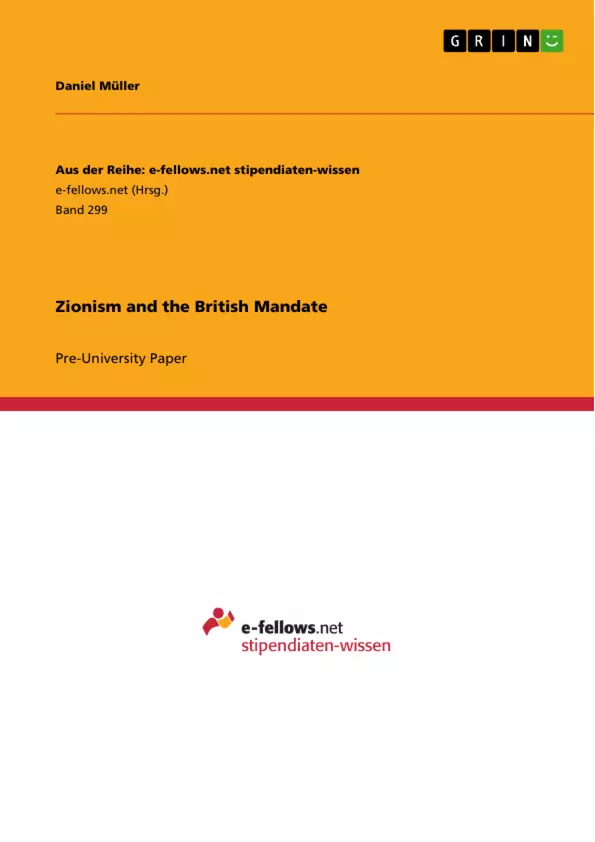The paper deals with the emergence of modern Zionism, spurred by pogroms and persecution directed against European Jewry. It highlights the situation in Palestine under Ottoman rule, before and after Jewish mass immigration.
The decades before the foundation of the Jewish state are of particular interest. The British Mandate period illustrates the competing struggle of two ethnic groups, i.e. Arabs and Jews, for sovereignty in the entity called Palestine. A superpower (Great Britain) attempts to contain sparking violence and works hard on equitable and fair solutions, e.g. various partition plans (two-state solutions). Modern-day politicians and conflict analysts should take this history into account.
Inhaltsverzeichnis (Table of Contents)
- I. Introduction
- II. Zionism and the British Mandate
- 1. Zionism
- 1.1. Definition
- 1.2. Forerunners
- 1.3. Theodor Herzl
- 1.3.1. Life
- 1.3.2. Zionist work
- 1.4. Other Zionist mainstreams
- 2. Palestine
- 2.1. Palestine under Ottoman rule
- 2.2. Palestine during World War I
- 2.3. The Balfour Declaration
- 2.4. The Mandate
- 2.5. Early riots and hostilities
- 2.6. The civil administration
- 3. Zionist politics in Palestine
- 3.1. Reactions after Jaffa
- 3.2. Zionist organization and policy
- 4. Escalation of the ‘war’
- 4.1. The screen incident
- 4.2. Outburst of violence
- 5. Terror
- 5.1. Reactions
- 5.2. The Passfield White Paper
- 5.3. Arab nationalism
- 5.4. The Arab Rebellion
- 5.4.1. Start and strike
- 5.4.2. Zionist policy and reaction
- 5.4.3. The Peel Commission
- 5.4.4. Suppression
- 5.4.5. The British White Paper
- 6. World War II
- 6.1. Zionist policy
- 6.1.1. General line
- 6.1.2. Means to fight the White Paper
- 6.1.3. Cooperation with the British Army
- 6.2. Terror against the British
- 6.3. The end of the War
- 6.1. Zionist policy
- 7. A Jewish state
- 7.1. Jewish terror
- 7.2. The end of the Mandate
- 7.2.1. Britain’s position
- 7.2.2. The partition plan
- 7.2.3. The ‘War of Independence’
- 1. Zionism
- III. Conclusion
- IV. Appendix
- A) Annotations
- B) Maps
- C) Sources
Zielsetzung und Themenschwerpunkte (Objectives and Key Themes)
This work seeks to examine the relationship between Zionism and the British Mandate over Palestine during the early 20th century. It focuses on the political, social, and economic factors that influenced the development of the Zionist movement in Palestine, as well as the complex relationship between Zionists, Arabs, and the British administration.
- The rise of Zionism as a political movement and its key figures, including Theodor Herzl.
- The political landscape of Palestine under Ottoman rule and the emergence of Arab nationalism.
- The Balfour Declaration and its impact on Zionist aspirations and Arab concerns.
- The British Mandate for Palestine and its complex implementation, balancing Zionist ambitions with Arab interests.
- The escalating tensions between Zionists and Arabs, including episodes of violence and terrorism.
Zusammenfassung der Kapitel (Chapter Summaries)
- I. Introduction: This chapter sets the stage for the discussion by introducing the historical context of the Jewish diaspora and the yearning for a return to Zion, culminating in the establishment of the State of Israel in 1948.
- II. Zionism and the British Mandate: This section provides a comprehensive analysis of the Zionist movement and its development in Palestine, including its origins, key figures, and major political and ideological currents. It also examines the historical context of Palestine under Ottoman rule, the Balfour Declaration, the British Mandate, and the escalating tensions between Zionists and Arabs.
- 1. Zionism: This chapter defines Zionism and traces its development from its forerunners to the emergence of Theodor Herzl as a key figure.
- 2. Palestine: This chapter details the history of Palestine under Ottoman rule, the impact of World War I, and the subsequent implementation of the Balfour Declaration and the British Mandate. It also explores the emergence of early riots and hostilities between Jews and Arabs.
- 3. Zionist politics in Palestine: This chapter examines the organization and political strategies of the Zionist movement in Palestine, including the establishment of institutions and the development of different Zionist parties.
- 4. Escalation of the ‘war’: This chapter focuses on the escalation of violence between Zionists and Arabs, particularly the screen incident at the Western Wall and the ensuing outbreak of violence in 1929.
- 5. Terror: This chapter explores the rise of terrorism in Palestine, with a focus on the reactions of the Zionist movement and the British administration, the emergence of Arab nationalism, and the Arab Rebellion.
- 6. World War II: This chapter examines the impact of World War II on Zionist policy and the relationship between Zionists and the British. It also explores the continuation of terrorism against the British.
- 7. A Jewish state: This chapter covers the final stages of the British Mandate, culminating in the declaration of the State of Israel in 1948. It examines the escalation of Jewish terrorism, the UN partition plan, and the ensuing “War of Independence.”
Schlüsselwörter (Keywords)
This work focuses on the intersection of Zionism, the British Mandate, and the Arab-Jewish conflict in Palestine. Key concepts include the Balfour Declaration, the British administration, Arab nationalism, Zionist aspirations, the rise of terrorism, the Peel Commission, and the UN partition plan. The analysis highlights the complex political dynamics and the interplay of different ideologies and actors in shaping the destiny of Palestine.
- Citation du texte
- Daniel Müller (Auteur), 2007, Zionism and the British Mandate, Munich, GRIN Verlag, https://www.grin.com/document/179549



